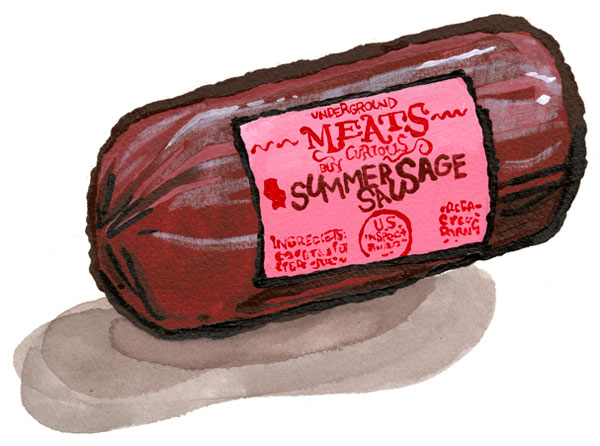I grew up in Michigan. We often had summer sausage in the fridge. But mention summer sausage to a friend from California and chances are they’ve never even heard of it. Why is it so ubiquitous in the midwest and so unknown elsewhere in the country?
Summer sausage is in every grocery store in the midwest.
For those who didn’t grow up with summer sausage, here’s a quick overview. Despite the name, it’s more of a salami than a sausage—it’s cured, stable at room temperature, and ready to slice and eat with no cooking. It’s usually about two inches in diameter and about six to eight inches long. The sausage is a deep rosy pink with small white flecks of fat. It almost always comes wrapped in a waxy, maroon casing. It’s a fibrous, papery material that you can’t eat, so you peel it away as you cut off slices. It’s soft—similar to the texture of bologna, but bologna you slice a quarter-inch thick. The flavor is a bit tangy, a bit sweet, a bit spicy.
The name summer sausage comes from the days before refrigeration. After the slaughter in the fall, you’d make the sausage from the leftover bits of meat—often including organs. The sausage would go through two processes that allow it to keep until the next summer, hence the name. First is a lactic acid fermentation—the same process used to ferment foods like sauerkraut, kimchi, and yogurt. The fermentation lowers the pH of the meat, inhibiting microbial activity and allowing it to keep without refrigeration. It also gives the meat a tangy flavor. The second process is curing, which removes some of the moisture in the meat and further inhibits those microbes. By combining the curing with the fermentation, summer sausage doesn’t need to be dried as much as a hard salami to be able to keep at room temperature. Compared to most salami, summer sausage is practically juicy.
The recipe for summer sausage came to the US when German immigrants settled in the midwest in the late 1800s and brought their recipes with them. It’s a common story shared by many midwestern meats—including Usinger’s liverwurst from Milwaukee or Nueske’s applewood smoked bacon from Wittenberg, Wisconsin.
Our summer sausage comes from Underground Meats in Madison, Wisconsin.
Underground Meats is part of the Underground Food Collective, a group of food businesses including a catering company, a restaurant, a meat processing facility, and a butcher shop, started by Jonny Hunter. Jonny is one of the most remarkable people you’ll find in the food world. He’s a James Beard nominated chef with no formal culinary training. When you talk to him, he casually mentions things like how he recently spent a day at a vegetable auction to buy a bunch of peppers for the hot sauce company he just started. And though he continues to rack up accolades, he’s quick to share his success with everyone around him—even competitors. When he set up his HACCP food safety plan to get USDA certification for his cured meats, he open sourced his work so that other salami producers could get USDA certification, too.
Through his meat processing plant, Jonny provides a source for whole animal butchery to restaurants throughout the Madison area. The animals he works with—including the ones that provide the meat for the summer sausage—are raised humanely and sustainably without hormones or antibiotics.
Jonny’s summer sausage starts with that pasture raised pork and beef, and, as is traditional in Germany, a bit of organ—here, beef heart. It’s seasoned with mustard seed, coriander and allspice. The result is one of the best summer sausages I’ve ever tasted (in spite of my childhood nostalgia for the ubiquitous grocery store stuff): bright and tangy with a deep meaty sweetness, a bit of warm spice, and a texture that nearly melts in your mouth. It’s got all the elements of the standard summer sausages I grew up with, but with more complex flavor.
Summer sausage is the ultimate meat to eat with a cracker.
A quarter-inch thick slice fits pretty darn perfectly on a Ritz—and so much the better if you top it off with a nib of cheddar. I know plenty of folks who like to take a few slices of summer sausage and layer them in a sandwich with a good slather of butter or mustard. Since it doesn’t need refrigeration it’s a great choice to bring along on a hike, to a picnic, or for a camping trip. It’s also standard midwestern fare for a tray of finger foods for a party. If you went to a party hosted by Zingerman’s Mail Order co-founder Mo’s family, you’d find summer sausage included in a spread with deviled eggs, olives, pickles (small dills and bread & butter pickles), celery, carrot slices, ranch dressing, and Club crackers.

